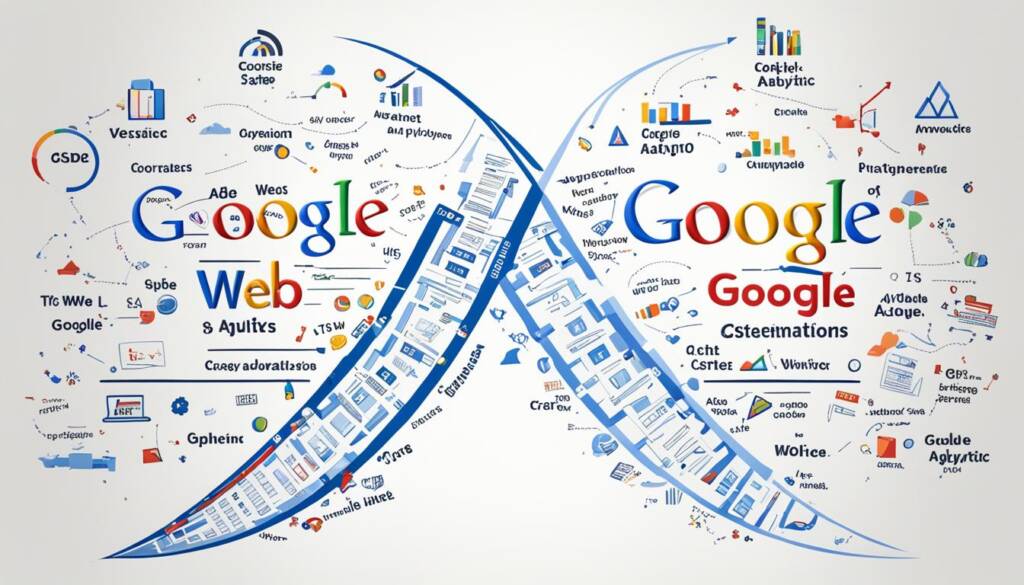Choosing between Adobe Analytics and Google Analytics is a big decision for businesses. Both tools are great at giving insights into customer behaviour and digital marketing. But, they are not the same. This article will show you how they differ and which one might be right for your business.
Google Analytics is easy to use and works well with Google Ads and Search Console1. It’s perfect for beginners. Adobe Analytics, however, is geared towards big companies. It has advanced features that go beyond basic web reporting2.
Adobe Analytics has changed a lot over time. It now has the Analysis Workspace, which makes looking at data fun and interactive. This shows Adobe’s effort to make data sharing and teamwork easier in companies2. Google Analytics also has free and paid options. It’s easy to get into but still offers a lot of detail1.

Key Takeaways
- Adobe Analytics is great for advanced features like segmentation and real-time reporting1.
- Google Analytics is easy to start with and set up2.
- Both tools work well with their marketing suites1.
- Adobe Analytics’ Analysis Workspace is perfect for complex data visualisation and teamwork2.
- Google Analytics 4 can track up to 50 conversions and comes in free and paid versions3.
Overview of Adobe Analytics and Google Analytics
The digital world has made businesses more visible online, making digital analytics tools crucial. Google Analytics and Adobe Analytics are top choices for collecting data from various channels. This section looks at these two leading platforms used in marketing.
Introduction to Google Analytics
Google Analytics 4 (GA4) started in 2020 and will replace Universal Analytics in 20234. GA4 tracks user actions on websites and apps, giving real-time updates and event reports4. It’s popular for its ease of use, offering a free plan for startups and small businesses, and detailed insights into online traffic5. For bigger needs, the GA360 premium plan costs $150,000 a year5.
Introduction to Adobe Analytics
Adobe Analytics is part of the Adobe Cloud Suite, aimed at big companies. It excels in web analytics and predictive analytics4. It has advanced features like detailed segmentation and real-time analysis, fitting complex data needs5. The platform offers tools like customizable workspaces for data visualisation6. Prices for Adobe Analytics vary widely, from $48,000 to $350,000, based on the complexity5.
Usability and User Interface Comparison
Google Analytics and Adobe Analytics have different interfaces. Google Analytics is easy to use and has templates for quick insights4. It suits businesses just starting with data analytics4. Adobe Analytics, on the other hand, is more customizable, requiring a deeper understanding of data4. It lets users tailor reports and export data through Supermetrics connectors4.
Google Analytics focuses on quick insights and key metrics, while Adobe Analytics goes deeper into data analysis4. This shows how each platform approaches analytics differently, with Google focusing on ease and Adobe on depth4.
Key Comparisons: Adobe Analytics vs Google Analytics
Adobe Analytics and Google Analytics are both top choices for web analytics. They help analyse website traffic and how customers interact with sites. Each tool has unique strengths, especially in website traffic analysis, implementation, and how they present data.
Website Traffic Analysis
Google Analytics is great for tracking website traffic. It shows page views, session lengths, and how engaging your site is. It’s perfect for businesses that value simplicity and fit well with Google tools78.
Adobe Analytics, however, is all about advanced tracking and real-time data. It has tools like Analysis Workspace for deep analysis8. Plus, it keeps data safe, meeting strict data protection laws8.
Implementation Process
Setting up Google Analytics is easy, needing just a simple JavaScript tag on your site7. It’s great for any business size. Adobe Analytics, though, requires more work and an expert’s touch7. But, it’s worth it for detailed data and advanced tracking8.
Reporting and Data Visualisation
Both tools offer strong reporting and visualising data. Google Analytics has ready-made reports for quick insights78. Adobe Analytics, on the other hand, has Analysis Workspace for custom reports and predictive analysis78. It also has pathing analysis for deep customer journey insights7.
Source Links
- https://salespanel.io/resources/google-analytics-vs-adobe-analytics/
- https://keyrus.com/be/en/insights/adobe-analytics-vs-google-analytics-which-one-is-right-for-your-company
- https://axamit.com/blog/adobe-analytics/google-analytics-vs-adobe-analytics/
- https://supermetrics.com/blog/google-analytics-4-vs-adobe-analytics
- https://www.akkio.com/post/google-analytics-vs-adobe-analytics
- https://experienceleague.adobe.com/en/perspectives/transitioning-to-adobe-analytics
- https://www.fullstackanalyst.io/blog/web-analytics/please-stop-comparing-adobe-analytics-to-google-analytics/
- https://www.theknowledgeacademy.com/blog/adobe-analytics-vs-google-analytics/


